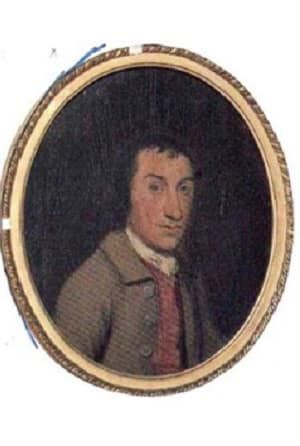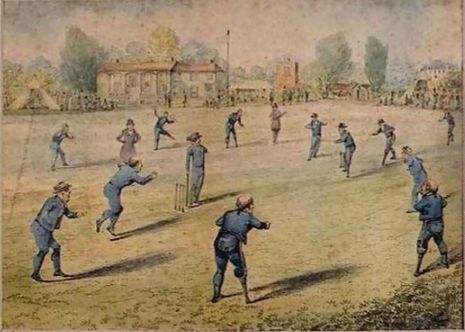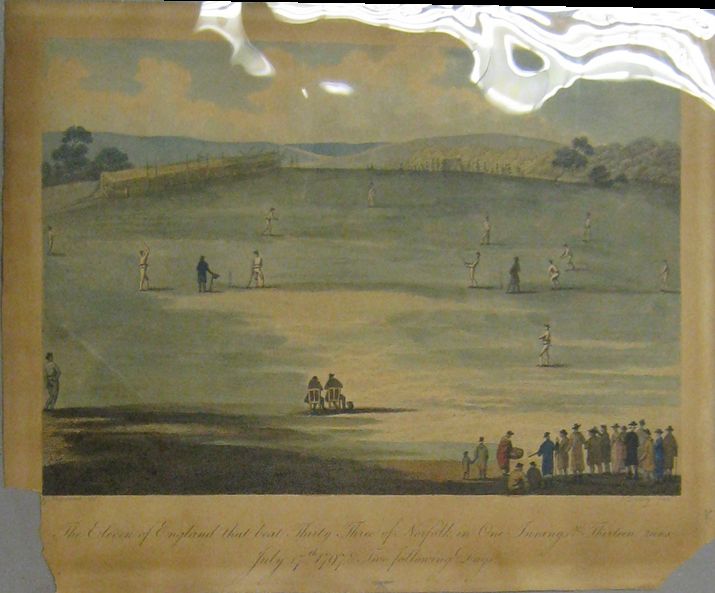Matches to Remember
This section gives some details of a small number of the famous matches of the period. Famous that is because records have survived; most matches are lost to history. I hope to add to this page in due course.
Surrey and Sussex v London (1744)
| Dates | 2 June 1744 |
| Ground | Artillery Ground |
| Teams | Surrey and Sussex (or Slindon) v London |
| Format | Double wicket, eleven-a-side, two innings |
| First innings of team batting first | Surrey and Sussex 102 (George Jackson 19) |
| First Innings of team batting second | London 79 (Butler 18) |
| Second Innings of team batting first | Surrey and Sussex 102 – 6 declared (John Harris 47) |
| Second Innings of team batting second | London 70 (Stephen Dingate 19) |
| Result | Surrey and Sussex won by 55 runs |

The Sussex and Surrey team consisted of Edward Aburrow and Richard and AdamNewland
of Slindon, reinforced by well-known players from Eastbourne, Hamilton, Addington and Lingfield.
The card is the first available for any match and gives the scores by each player and their surnames only, although it does differentiate between the two pairs of brothers (the Harrises and Newlands) who were playing. The Daily Advertiser carried the names of players expected to play in the match on 1–2 June and reported the same names on 3 June, although some of them do not appear on the scorecard.
England v Kent (1744)
| Dates | 18 June 1744 |
| Ground | Artillery Ground |
| Teams | England v Kent |
| Format | Double wicket, eleven-a-side, two innings |
| First innings of team batting first | England 40 (Newland 18) |
| First Innings of team batting second | Kent 53 |
| Second Innings of team batting first | England 70 (Newland 15) |
| Second Innings of team batting second | Kent 58 for 9 |
| Result | Kent win by one wicket |

In reporting the match London Daily Advertiser described it as the “greatest cricket match ever known”. It was a noted social occasion as the spectators included the Prince of Wales and his brother, Prince William, Duke of Cumberland, the 2nd Duke of Richmond and Admiral Vernon. James Love (1722–1774) commemorated the match in his Cricket: An Heroic Poem (1745).

A ticket for this match. The engraving is from Boitard, Smith is the name of the Artillery ground promoter. The price, two shillings, six pence, is quite expensive, perhaps £40 in today’s money. What a wonderful survival!
Hampshire / Hambledon XI v England (1772)
| Dates | 24-25 June 1772 |
| Ground | Broadhalfpenny Down |
| Teams | Hampshire / Hambledon XI v England |
| Format | Double wicket, eleven-a-side, two innings |
| First innings of team batting first | Hampshire / Hambledon XI 146 (John Small 78) |
| First Innings of team batting second | England 109 (Thomas White 35) |
| Second Innings of team batting first | Hampshire XI 79 |
| Second Innings of team batting second | England 63 (John Small 34) |
| Result | Hampshire / Hambledon XI won by 53 runs |
There is general confusion as to whether the team playing in this match was Hambledon or Hampshire, and even the eminent writers on the history of the game cannot agree. There are no surviving reports of the match, nor any details of how the dismissals occurred. Lumpy Stevens played for England in this match.

It is recognised in some quarters (CricketArchive, ESPN cricinfo, MCC) as being the first first-class match. This is because it has a full batting list and scores available, the absence of bowling figures notwithstanding.
Surrey v Kent (1773)
| Dates | 19-21 July 1773 |
| Ground | Bishopsbourne |
| Teams | Surrey v Kent |
| Format | Double wicket, eleven-a-side, two innings |
| First innings of team batting first | Surrey 77 (Will Palmer 22; Duke of Dorset 4 wickets) |
| First Innings of team batting second | Kent 63 (Duke of Dorset 25; John Wood 4 wickets) |
| Second Innings of team batting first | Surrey 217 (Robert Stone 24, Will Palmer 38, Thomas White 60, M Lewis 21*) |
| Second Innings of team batting second | Kent 78 (George Louch 26) |
| Result | Surry won by 153 runs |

This match was the second of four encounters between Kent and Surrey in 1773 and was celebrated by John Duncombe in the poem Surrey Triumphant or The Kentish Men’s Defeat . The first of these has been recognised as the first first-class match between two counties.
Kent v Surrey (1773)
| Dates | 16 – 18 August 1773 |
| Ground | Sevenoaks |
| Teams | Kent v Surrey |
| Format | Double wicket, eleven-a-side, two innings |
| First innings of team batting first | Surrey 171 (Thomas White 59, Francis Booker 3 wickets) |
| First Innings of team batting second | Kent 142 (John Wood 37, Richard Miller 42) |
| Second Innings of team batting first | Surrey 70 (John Frame 3 wickets) |
| Second Innings of team batting second | Kent 100-4 (John Minchin 32, Richard Miller 32) |
| Result | Kent won by 6 wickets |

The final match of the series of four between these counties, Kent registered a win after losing the previous three. This was celebrated by another poem – The Kentish Cricketers by John Burnby. After this flurry of matches, there seems to have been no more than four further matches between the two counties between 1773 and 1828.
England vs Hampshire XI (1773)
| Dates | 4-5 August 1773 |
| Ground | Broadhalfpenny Down |
| Teams | England vs Hampshire XI |
| Format | Double wicket, eleven-a-side, two innings |
| First innings of team batting first | Hampshire XI 89 (Lumpy Stevens 4 wickets, Duke of Dorset 4 wickets) |
| First Innings of team batting second | England 202 (Palmer 68, Thomas White 69, Purchase four wickets) |
| Second Innings of team batting first | Hampshire XI 140 (Sueter 39, Lumpy Stevens 3 wickets, Duke of Dorset 2 wickets) |
| Second Innings of team batting second | England 28-1 |
| Result | England won by 9 wickets |

This match is considered by John Goulstone to be the most likely match when the wide bat incident took place, based on the following:
- The document formerly held by the Bat and Ball Inn dating this as being in September 1771 has been discredited.
- As Nyren recalls the incident from his childhood days, it must have been at his home ground – Broadhalfpenny Down, and
- We know from Nyren that the incident features one ‘White of Reigate’ – and Thomas White seems to be the only candidate for this role (not someone called Shock White as has been thought in years gone by). This was the only match he played at Broadhalfpenny Down, where he did well.
Kent, with Lumpy v Hambledon (1775)
| Dates | 22-23 May 1775 |
| Ground | Artillery Ground |
| Teams | Five of Kent (including guest) v Five of Hambledon |
| Format | Single wicket, five-a-side, two innings |
| First innings of team batting first | Kent 37 (Brett 3 wickets) |
| First Innings of team batting second | Hambledon 92 (John Small 75; Lumpy 5 wickets) |
| Second Innings of team batting first | Kent 102 (W. Bullen 56, F Booker 35; Brett 4 wickets) |
| Second Innings of team batting second | Hambledon 48-4 (T. Sueter 15, John Small 14*; Lumpy three wickets) |
| Result | Hambledon won by 1 wicket |

A five-a-side match filled with the great names of Early Cricket – Lumpy (pictured), Brett, Small sr, Sueter, White and Lear. Lumpy with 8 wickets and John Small with a first innings 72 dominate the scorecard. It was Small’s second innings of 14 not out, when he was held back to be the last man, that decided the match, but it was not without luck. Lumpy bowling three balls straight through Small’s stumps, but he survived to win the game. This provided the impetus for a rule change whereby the number of stumps was changed from two to three.
One of the very last games at the Artillery Ground of the period, cricket finished there in 1778, not to resume until 1846. Lumpy Stevens was a Surrey player, brought into the Kent side for the occasion.
Hambledon v All England (1777)
| Dates | 18-20 June 1777 |
| Ground | The Vine, Sevenoaks |
| Teams | England v Hambledon |
| Format | Double Wicket, eleven-a-side, two innings |
| First innings of team batting first | England 168 (Minishull 60*; Brett 6 wickets) |
| First Innings of team batting second | Hambledon 403 (James Aylward 167, John Small 33, Tom Sueter 46, Tom Taylor 32, Richard Nyren 37; Wood 5 wickets, Lumpy 3 wickets) |
| Second Innings of team batting first | England 69 |
| Second Innings of team batting second | Not required |
| Result | Hambledon won by an innings and 168 runs |

The greatest of all Hambledon results with heroic roles for many of the players for the generation of players so lauded by John Nyren. Unfortunately for the sake of myth-preservation, it was not at Broadhalfpenny Down, but at Sevenoaks, but a remarkable resut, not least for Hambledon’s achievement of a score in excess of 400, anchored by James Alyward’s quite astonishing 168. A match for the ages.
The scorecard shown is not correct as far as batting order is concerned, Alyward is believed to have gone in first. The match was played for a thousand guineas.
The Hambledon Club / Hampshire played England XI a total of 51 times, winning 29 of those matches.
One Leg v One Arm (1796)
| Dates | 9-10 August 1796 |
| Ground | Montpellier Gardens Walworth |
| Teams | Greenwich Pensioners – One Legged v One Armed |
| Format | Double Wicket, eleven-a-side, two innings |
| First innings of team batting first | One Legged 93 |
| First Innings of team batting second | One Armed 41 |
| Second Innings of team batting first | One Legged 104 |
| Second Innings of team batting second | One Armed 53 |
| Result | One legged win by 103 runs |

An example of a so-called novelty match, it could equally be seen as an early venture into disability sport. Press reports indicate that there had been a great commotion while they were batting, as many would-be spectators broke down a gate and some fencing to get in. Some climbed on top of a stable, which collapsed, so they were bruised.
There were several matches of this nature, held for the benefit of the Greenwich Pensioners. One was held as late as 1848 and was reported on by Charles Dickens in his magazine, All the Year Round.
Norfolk v England (1797)
| Dates | 17-20 July 1797 |
| Ground | Race Course at Swaffham |
| Teams | Norfolk v England |
| Format | Double Wicket, 33 for Norfolk. 11 for England, two innings |
| First innings of team batting first | England 144 (Tom Walker 55, Beauclerk 39) |
| First Innings of team batting second | Norfolk 50 all out – i.e. for 32 wickets (Beauclerk 7 wickets) |
| Second Innings of team batting second | Norfolk 80 all out – i.e. for 32 wickets |
| Second Innings of team batting first | Not required |
| Result | England won by an innings and 14 Runs |

An astonishing mismatch. Thirty-three of Norfolk were not enough to avoid an innings defeat. Norfolk lost a total of 64 wickets for 130 runs, just over two runs per wicket. It does go to show how difficult batting could be against the best bowlers.
It seems from accounts that Norfolk followed on by agreement.